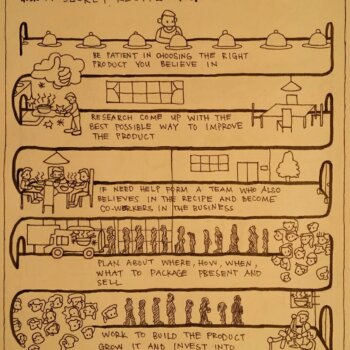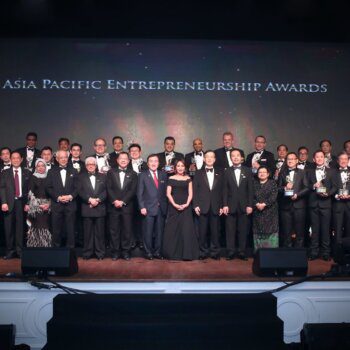If you’re a businessperson or someone interested in understanding how to facilitate innovation, you’ve probably heard of “design thinking” by now. Coined by IDEO’s David Kelley, the term refers to a set of principles, from mindset to process, that can be applied to solve complex problems. I’ve seen articles lately ranging from those that highlight its potential, [Design Thinking for Social Innovation, How does design thinking give companies a competitive advantage?] to those that warn of it’s impending failure as a practice [Why Design Thinking Won’t Save You , The Coming Boom and Bust of Design Thinking]. I’ve been eager to enter into the conversation, especially because some of the arguments around the topic don’t make sense to me and I wanted to know why. Change by Design, written by IDEO’s CEO Tim Brown, was on my winter reading list anyway, so I decided to finish it before bringing in my own perspectives.
I just got through the book a few days ago, and feel like I “get it.” So I’ve spent a few days reflecting on it and rereading some innovation articles, and think there is a bigger picture at the essence of design thinking that is being lost on some. I’m going to provide a brief summary of the book (from my interpretation), and tie in some other areas that brought me insights into these ideas.
Design Thinking as a Path to Innovation
Though the subtitle of the book is “How Design Thinking Transforms Organizations and Inspires Innovation,” what Brown is actually proposing in this book goes far beyond offering advice for keeping your business on the leading edge of innovation. He’s talking about a new ethos in how we operate as a society. That concept feels pretty big, so it’s packaged as a business innovation book instead in order to overcome the challenge of getting you to open it. Not that you’re being tricked – it IS about innovation, but it’s extended beyond the scope of designing products and services to encompass the way we design the systems in which we live. After seven chapters of explaining design thinking as it relates to your organization, he gets to the meat and potatoes with chapters titled ‘The New Social Contract,’ ‘Design Activism,’ and ‘Designing Tomorrow – Today.’
He begins to frame this within the opening pages of the book:
What we need are new choices – new products that balance the needs of individuals and of society as a whole; new ideas that tackle the global challenges of health, poverty, and education; new strategies that results in differences that matter and a sense of purpose that engages everyone affected by them.
He goes on to identify 3 key spaces of innovation, which function as overlapping stages of a process: inspiration, ideation, and implementation. You can read a more thorough explanation of these stages in this article, but here’s the short version:
inspiration: the problem or opportunity that motivates the search for solutions
[this stage involves sketches, mock-ups, and scenario-building]
ideation: the process of generating, developing, and testing ideas
[this stage involves building prototypes & exploring the balance between practical functionality and emotional appeal]
implementation: the path that leads from the project room to the market
[this stage involves clearly communicating the idea and proving/showing that it will work]
It’s a simple enough of a framework, one that shares many components with any well-devised design or research process. As he explains the approach, he highlights that innovation must occur within a set of constraints, such as economic viability, and that a traditional business-minded rational/analytic approach must be maintained as well. I mention this because some of the articles I’ve read that bash design thinking seem to complain that the approach is an abandonment of good ‘business thinking.’ For instance, here’s a quote from an article in Harvard Business Review titled ‘Why Design Thinking Won’t Save You‘:
Design thinking is trotted out as a salve for businesses who need help with innovation. The idea is that the left-brained, MBA-trained, spreadsheet-driven crowd has squeezed all the value they can out of their methods. To fix things, all you need to do is apply some right-brained turtleneck-wearing “creatives,” “ideating” tons of concepts and creating new opportunities for value out of whole cloth.
I’m kind of surprised by the statement, because Brown never makes a statement that sounds like “all you need to do is…” He actually repeats many times throughout the book that there needs to be a combination of the intuitive/emotional with the rational/analytic, a “balance of management’s legitmate requirement for stability, efficiency, and predictability with the design thinker’s need for spontaneity, serendipity, and experimentation.” If anything, he’s calling for a holistic interdisciplinary approach to business that breaks down the rigid silos of standard organizational structure that, in its very design, impedes creativity, collaboration, knowledge sharing, and in turn, innovation.
Tools for Design Thinking
The design thinker uses a set tools and skills that inform and facilitate the innovation process, from visual tools like sketches, mind maps and prototypes to mental processes like brainstorming, building on the ideas of others, and creating scenarios. They operate on principles that encourage collective ownership, like “all of us are smarter than any of us,” and adhere to ‘rules’ that promote organizational creativity, like having permission to fail, experiment, take risks, and explore the full range of their faculties. They rely on their “ability to be intuitive, to recognize patterns, and to construct ideas that have emotional meaning as well as functionality.” But these practices and techniques are not unique to the design thinker.
As I commented on Bruce MacGregor’s article ‘How does design thinking give companies a competitive advantage?,’ the principles of design thinkers are also those used by futurists. (A good introductory article to Futures Thinking was written up by Jamais Cascio in Fast Company, found here.) Though the terminology is different, the process is very similar. Again, I mention this because there is some argument around design thinking which seems to be coming down to semantics – “it’s really just social science,” or “it’s just futures thinking repackaged.”
So, what is design thinking then?
The strategies and tactics reviewed so far are probably familiar to you if you’ve read literature on creativity and innovation. You can pull up the innovation sections of the major business management publications, and find that the articles will give you a similar flavor as what’s mentioned above. So how does design thinking make this any different?
Whether it’s called design thinking, lateral thinking, right-brain thinking, systems thinking, integrative thinking, futures thinking, or my own term of ‘metathinking,’ from my perspective, the concept itself is rooted in a capacity to understand the world and our relationship to it, and within it, in a different way.
Design thinking is a “human-centered approach,” and for me that means truly getting down to the core of what we think it means to be human, of what it ‘should’ look like, and how we want to experience life. When we see the word “design,” we may immediately think of just products made by a snooty designer; items we see displayed at a museum that bear no resemblance to something we’d find in our home, artwork that makes us somehow feel stupid because we don’t understand why it’s so special, or architecture that is said to make “a statement” but feels completely alien in the way it impacts us. That is not the same design that is being proposed by design thinking.
When I started my blog, I knew I wanted to write about emerging trends at the intersection of technology, communication, and culture. Many of the posts lately have been focused around social media technologies and how they’re allowing for a many-to-many communication structure that’s never been possible before in human history, and what the implications of such a thing could be. But really, those explorations are laying a foundation for a bigger question; namely, where do we go from here? My research brought me to systems theory and complexity theory, and I’ve been particularly interested in complex adaptive systems theory. It proposes that the world is full of systems; from the ecosystem in which we live, to the social systems we’ve constructed via civilization, to the online social systems we’re creating as we develop a network culture. It broadened my perspective on the way culture works to think of it as a complex series of interactions, full of meaningful patterns that shape our society whether we’re aware of them or not. It made me think about the many systems around us that are currently collapsing, from global economic systems, to governments, to educational institutional models, to healthcare. The talk about massive change is pervasive today, and many suggest we need to undergo a complete paradigm shift in the way we operate if we’re to survive in a fashion that’s desirable and sustainable. The good news is, that shift can be made with intentionality and choice. We’re citizens in an increasingly participatory culture, and I realized that that was the essence of what I wanted to write about – our ability to influence how we shape society. So I titled the blog Emergent by Design.
My posts have evolved to become a kind of storytelling and connecting the dots, and the comments sections have become conversation areas. We are engaging in a process of collectively inventing what we want, how we’d like to interact with it, and what we can do to make it happen. In my mind, this is at the heart of design thinking.
In a previous post, What is Social Media [the 2010 edition], I briefly covered the definition of “media” and illustrated how our entire manmade environment is a collection of media that act as representations of some other thing or idea. From convenient functionality,to casual ambiance, to childlike fantasy, to shared wisdom and personal histories, to a better ability to meet basic needs.
None of these examples happened by accident – they were done by design. They create a context that affects the reaction of the person experiencing them. So design is not just about the end product or service itself, but also the process of the interaction and the emotional response and intrinsic value that it provides. In that vein, design thinking is about the interaction between feasibility (what is functionally possible within the foreseeable future); viability (what is likely to become part of a sustainable business model); and desirability (what makes sense to people and for people), with an emphasis on the peoplefor which the product or service is being designed.
Synthesis
So whether you hope to employ design thinking to restructure the culture of an organization or to innovate a new product or service, it’s important to remember that it’s more than a set of simple tactics that can be implemented overnight. It’s more like a new ecology of mind, that takes time to grow, adapt, and evolve. It still requires an adherence to sound business decision-making, but also a commitment to challenge one’s own beliefs about “the way things work,” and to keep coming back to a human-centered approach by focusing on addressing people’s unspoken and unmet needs.
___________________________________________________________
About the Author
This article was written by Venessa Miemis, Founder of Emergent by Design, a blog exploring the co-evolution of humanity and our technologies.





























